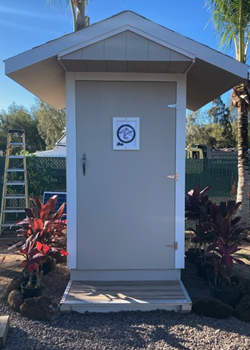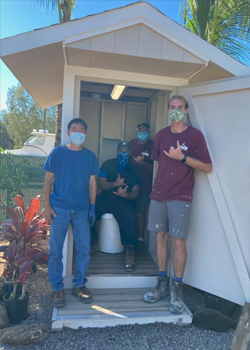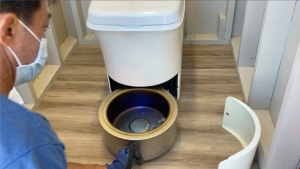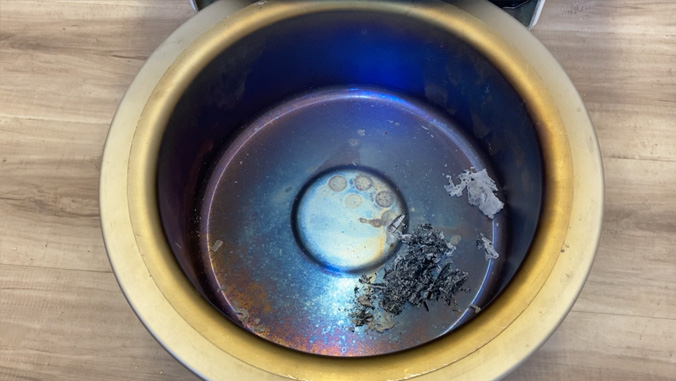The first state-of-the-art incineration toilet in Hawaiʻi that uses no water and produces no sewage is now in operation on the Moku o Loʻe (Coconut Island) in Kāneʻohe Bay at the University of Hawaiʻi at Mānoa’s Hawaiʻi Institute of Marine Biology (HIMB). The proof-of-concept project for reducing sewage pollution from environmentally damaging cesspool systems in Hawaiʻi, and is a collaboration between HIMB, Wastewater Alternatives and Innovations (WAI) and Cinderella Eco Group.
There are an estimated 88,000 cesspools in Hawaiʻi, the highest number per capita in the country, that discharge more than 53 million gallons of raw sewage each day, according to the Hawaiʻi Department of Health Wastewater Branch. The raw sewage of cesspools enters underground aquifers, which can pollute our drinking water, and coastal waters, which can damage fragile marine ecosystems. The Hawaiʻi Department of Health is requiring that all cesspools are upgraded, converted or closed by January 1, 2050.



“This kind of project is important for Hawaiʻi because our freshwater resources are continually going to become more scarce, our utilities are going to become more expensive, and our sewage systems are going to have more stressors put on them as population densities increase,” said Judy Lemus, interim director of HIMB. “We really need to protect our resources in Hawaiʻi and so a solution like the incinerator toilet is a great alternative.”
How it works
The toilet uses a small amount of energy from propane gas to incinerate both liquids and solids, and produces a pathogen-free, odorless ash that can be disposed of in the trash or used as a soil amendment in gardens or compost piles. The self-contained system does not require connections to municipal water, sewer or electrical infrastructure.
The design is simple and highly efficient. Liquid and solid wastes are drawn into an incinerator chamber powered by propane gas or electricity (the HIMB model uses propane gas). The waste is burned at approximately 540 degrees celsius into fine ash, which is collected in an ash container. The toilet can handle four uses per hour and the ash container only needs to be emptied once per week. HIMB estimates that the five gallon propane tank will last for 120–150 uses.
A model island
Located on the islet of Moku o Loʻe in Kāneʻohe Bay, HIMB is faced with many challenges that mirror those in Hawaiʻi. HIMB is connected to municipal water, sewer and electricity services on Oʻahu through high density polyethylene conduits that run underneath Kāneʻohe Bay. While cesspools are not the issue, resources are limited and utilities are expensive. The incineration toilet adds an environmentally sustainable bathroom on island for employees and visitors in a high traffic location where there were previously no facilities.
“We know that water is precious and scarce in Hawaiʻi and we really want to conserve water whenever we can,” said Lemus. “So as a conservation-based research institution we’re very interested in identifying sustainable solutions that will help us reduce our environmental impact.”
Cinderella toilet
WAI is an environmental nonprofit dedicated to reducing sewage pollution and restoring healthy watersheds by providing innovative, affordable and eco-friendly solutions to waste and wastewater management.
Cinderella Eco Group has been developing and selling incineration toilets since 1999. WAI’s Executive Director and Co-Founder Stuart Coleman first learned about the Norwegian-based company’s incineration toilets in 2018.
“Since then, we’ve been working with Cinderella to bring their innovative technology to Hawaiʻi,” Coleman said. “The current CEO’s father basically invented the incineration toilet so we are stoked to set up this pilot project at HIMB. It’s a great way to reduce sewage pollution and provide alternatives for areas with no sewer infrastructure.”
“These are waterless systems that don’t require water for flushing or a connection to a municipal sewage system, or an in ground septic system,” said Lemus. “They look exactly like a regular toilet, and they can burn both solid and liquid waste and they’re excellent for areas in which you don’t have any other municipal connections.”


